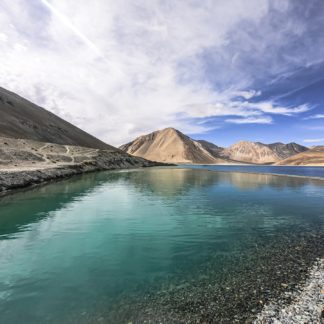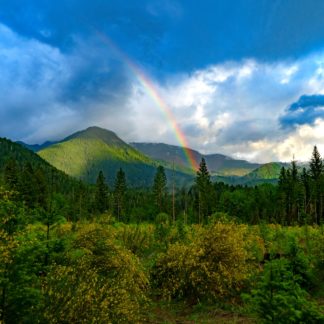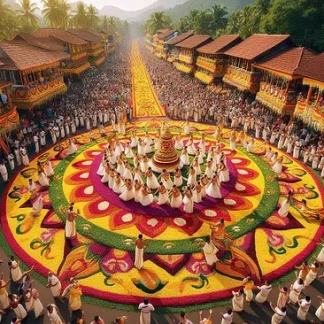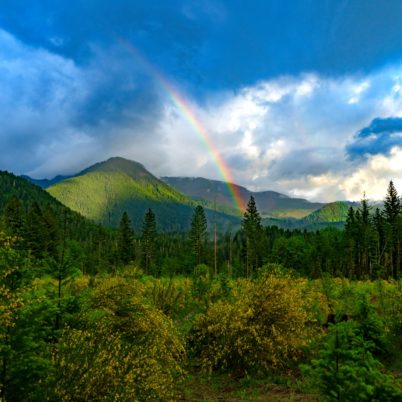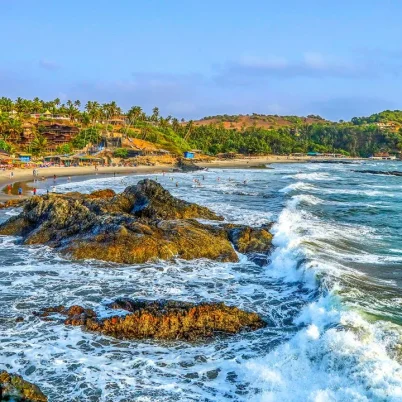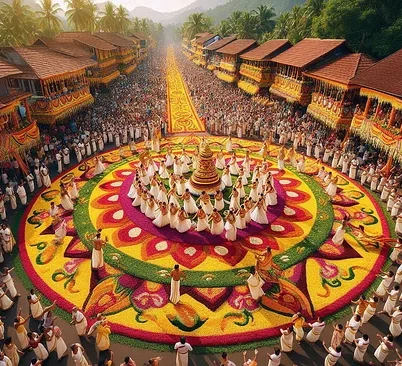The best time to visit India is between October and April, which is the comparatively cooler part of the year.
During this time, northern India has clear skies from October to November, while December and January are cooler with some fog. The higher Himalayas can be very cold but offer clearer mountain views. In April and May, rising temperatures bring humidity and thunderstorms, though it’s a good time for budget-friendly trips.
Ladakh, in the far north, is most accessible between June and September, as the rest of the country experiences monsoon rains.
The southern states are best visited from November onwards, once the monsoon season ends.
You can visit India throughout the year, since it is a large country, so geographically and climatically diverse.
Every season brings something different in different parts of the country. But if you ask us, February, March and November are the ideal months for visiting India.
When is the Best Time to Visit India?
- Ideal Months: October to April
- Top Picks: February, March, November
Weather Overview
- Winter (Oct-Mar): Pleasant, moderate temperatures, minimal rain
- Summer (Apr-Jun): Extremely hot, not ideal for travel
- Monsoon (Jun-Sep): Torrential rains across the subcontinent
Seasonal Highlights
- February: Pleasant across most of India
- March: Holi (Festival of Colors)
- November: Pushkar Camel Fair, sometimes Diwali (Festival of Lights)
February is one of the best months to visit India. You can travel to almost every part of this huge country in this month, from Himachal Pradesh and Uttarakhand in the north to Tamil Nadu and Kerala in the south. Experience pleasant, sunny weather in the majority of India in February.
Visit India in March for the vibrant festival of colors, Holi. November is a good time to visit India for the Camel Fair in Pushkar and sometimes, Diwali, the festival of lights.
The winters (from the end of October to the beginning of March) are mostly pleasant with moderate daytime temperatures and almost no precipitation.
The summer months of (mid) April, May and early June can get unbearably hot. However, it is a good time to visit the mountains, which are cool even during summer.
From June to September, the monsoon winds bring heavy monsoon rains across the entire subcontinent. During peak monsoon, the jungle regions and the low-lying delta lands in West Bengal often start flooding. However, it hardly ever rains in the country outside of the monsoon season.
That is why, the weather in India is an important factor to consider while picking the best time for visiting the country.
Another thing to consider are the festivals in India, which are an integral part of Indian culture and spread throughout the year. Having said that, India has something to offer at any time in the year.
From the mighty Himalayan foothills to the balmy beaches, it is all about picking the right destination based on when you are visiting India.
We will give you a broad overview on the best time to visit India, the best regions to visit for each season, the festivals you should not miss, and more, so that you can decide your travel plan and itinerary accordingly.
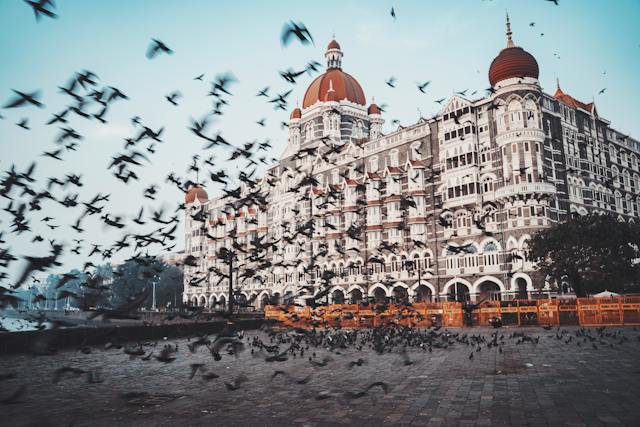
Best Season to Visit India – Month-by-Month Weather Guide
So, wondering when is the best time to visit India? Here is a detailed overview of what the weather would be like each month in India, in different regions of the country, feel free to explore.
January
- Weather: One of the driest months; very cold in North India.
- Best For: Snow in the Himalayas, beaches of Goa, backwaters of Kerala.
One of the driest months in India, it is way too cold at this time in the northern part of India. But if you want to experience snow, visit India to head up to the Himalayan foothills.
The rest of the country also gets slightly cooler, so it is a good time to visit the beaches of Goa or cruise the backwaters of Kerala.
26th January is India’s Republic Day, and a national holiday. The main Republic Day celebrations are held in New Delhi, and the Republic Day Parade is one of the major attractions of the day.
February
- Weather: Pleasant across most of India; clear skies and sunshine.
- Best For: Visiting most regions; Jaisalmer Festival in Rajasthan.
You can enjoy the most pleasant weather in India during February. Most of India experiences an amazing atmosphere. It is the ideal time to visit India’s majority of the regions, and tickets get booked quite in advance.
You will find clear skies and pleasant sunshine in most of India. You can visit both north and south India, the east, west, and central India, as well as the islands in India during these months. You could attend the Jaisalmer Festival in Rajasthan if you visit India during this time.
March
- Weather: Warm; before the intense heat starts.
- Best For: Touring the Golden Triangle (Delhi, Agra, Jaipur); Holi festival (Festival of Colors).
If you visit India in March, it is a good time to tour the Golden Triangle region of India – Delhi, Agra, and Jaipur – before the hot sunshine takes hold of the country from March onwards.
The Golden Triangle is a great way to witness the different facets of North India in a short time. But another reason to visit India in March is Holi, the festival of colours in India. The streets are filled with people drenching each other in colors and water – truly an experience you should not miss.
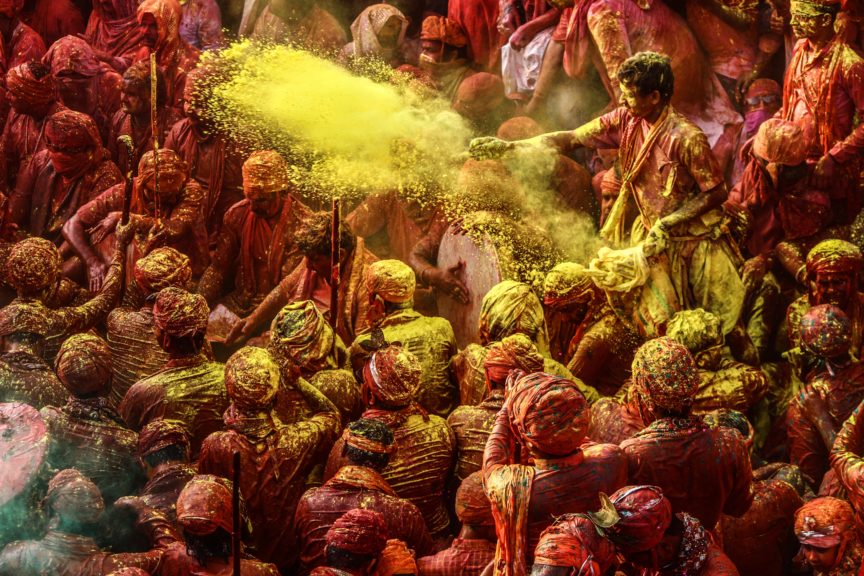
April
- Weather: Temperatures soar; hot weather and dry season.
- Best For: Wildlife viewing, especially tigers; spring flowers in North India; photography.
Temperatures soar in April, making it impossible to travel during daytime in some parts of India. However, if you are visiting India in April, this is one of the best times to visit the many national parks and wildlife sanctuaries in the country.
April is prime wildlife viewing season, especially for the majestic tiger of India – the royal Bengal tiger. Thanks to the hot sunshine, animal visits to watering holes are frequented, since those areas are comparatively cooler. This means the chances of spotting wildlife are greater.
April is spring season in the North, which means spring flowers bloom in Himachal Pradesh, Uttarakhand, and the Himalayas. The trekking season also starts in Himachal Pradesh and surrounding regions.
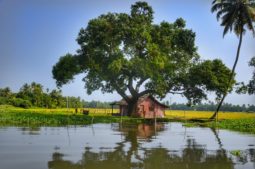
May
- Weather: Extremely hot; up to 45°C in some areas.
- Best For: Hill stations, North India, wildlife sightings in West India.
May means a hot and dry season for most of India. Temperatures can soar up to 45 degrees Celsius in this month, so the only way to beat the heat is to travel to hill stations, or explore the northern part of India.
Early mornings and evenings in May are also great for wildlife sightings in national parks, wildlife parks, and reserves in West India. Sometimes, this month experiences summer monsoon as well.
Buddha’s birthday, or Vesak, is celebrated on the full moon in May. It is one of the most important festivals for Buddhists all over the world. In South and Southeast Asia, Buddha’s birthday is celebrated as the thrice blessed day – his birth, enlightenment, and death all took place on this significant day.
June
- Weather: Start of monsoons; hot and humid.
- Best For: Escaping to Ladakh; off-season rates in most regions; mountain escapes.
It is the advent of summer monsoon in most of India from mid to late June. So you can escape to the far North if you visit India at this time.
The gorgeous Ladakh region is accessible from this month. If you don’t mind the humidity and rains, you can visit India in June and take advantage of the off-season rates almost all over the country starting from early June.
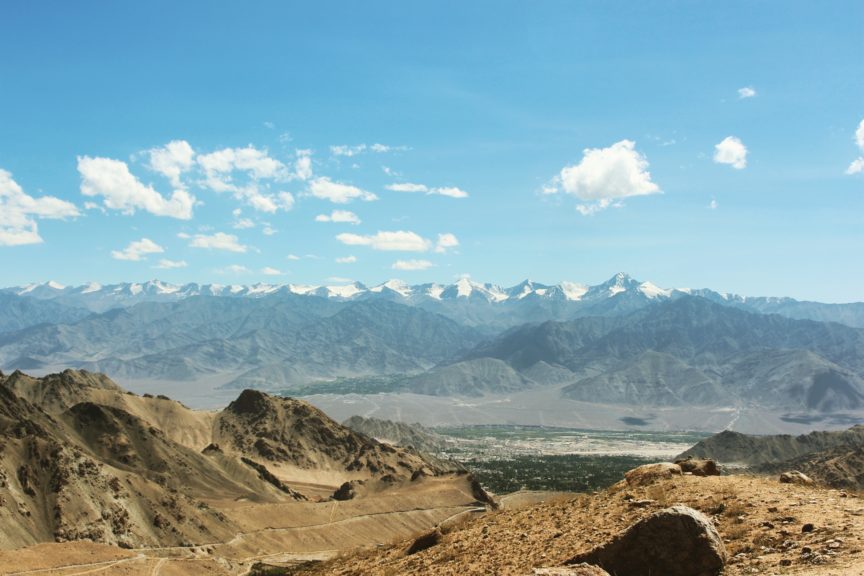
July
- Weather: Heavy rainfall; intense and prolonged downpours.
- Best For: Rajasthan, Thar Desert, Ladakh; local monsoon festivals.
July is the wettest month in India. Most of the country gets drenched as the monsoon rains arrive in July. This month sees regular and prolonged downpours and can sometimes severely disrupt communications with the intensity. The national parks close for the monsoon.
You could visit Rajasthan and the Thar desert during this month. Ladakh is also stunning at this time. July sees many local monsoon festivals being celebrated across India.
August
- Weather: Heavy rains; surreal views.
- Best For: Snake boat races in Kerala; Ganesh Chaturthi in Maharashtra; Independence Day celebrations.
It rains heavily in August in many parts of the country, but the views during this month are surreal.
Independence Day of India is celebrated on 15th August in the whole country. The Independence Day Parade is held in New Delhi and ends at the Red Fort.
You can check out the snake boat races in Kerala in August. Ganesh Chaturthi, the festival of the elephant-headed God, is celebrated with pomp in Maharashtra in August or September.
September
- Weather: Rain recedes; pleasant climate, sunny days.
- Best For: Golden Triangle; vibrant Rajasthan; Ganesh Chaturthi in Maharashtra, early tourist season, Durga Puja celebrations in West Bengal
As the rain recedes in September, it is a good time to visit the Golden Triangle region, since it is a bit early for the tourist season.
There is much less rain, especially in late September, so you can visit the Taj Mahal, Red Fort, and Hawa Mahal, the three monuments that make up a large part of the Golden Triangle. Rajasthan also becomes vibrant during September.
Durga Puja and Navratri often take place in late September or early October. There are a lot of festivities to look forward to during this period.
October
- Weather: Pleasant across the country.
- Best For: Visiting India; Mahatma Gandhi’s birthday (2nd October); Diwali (Festival of Lights).
The climate is pleasant in October in most of the country. With the amazing atmosphere, it is one of the best times to visit India. 2nd October is a national holiday in India as it is Mahatma Gandhi’s birth anniversary.
Diwali, the Hindu festival of lights, also occurs in October or November, making it a peak season for travel in India. Diwali is India’s biggest festival. You can witness streets lit up with rows and rows of diyas and firecrackers.
Explore More: Travel advice for US tourists Visiting India
November
- Weather: Cool and dry weather; one of the best months for travel.
- Best For: Visiting anywhere in India; Pushkar Camel Fair; Diwali.
It is usually a dry and cool season in November throughout the country, and one of the best times to visit India. November kickstarts the peak travel season in the country.
Darjeeling in West Bengal is especially pleasant in November. The Pushkar Camel Fair happens in November, and it is an extraordinary experience. Sometimes, the Diwali festival takes place in November.
The regions of Himachal Pradesh and Uttarakhand are great for adventure activities like trekking and paragliding at this time.
December
- Weather: Busy tourism season; cooler temperatures.
- Best For: Christmas and New Year celebrations; crowded Goa.
December is one of the busiest months for travel and tourism. You will find temperatures dropping towards the end of this month.
Domestic tourists and international travellers have their winter break with Christmas day and New Year’s, so everything is booked well in advance for the peak season. Goa is especially crowded in December.
Explore Further: 20 Must-Visit Places in North India
January | February | March | April | May | June | July | August | September | October | November | December
Simply hit the Plan Your Trip button and we’ll help simplify it all. Let us help you travel your way, keeping in mind all your interests and requirements while exploring the best of this vibrant subcontinent.
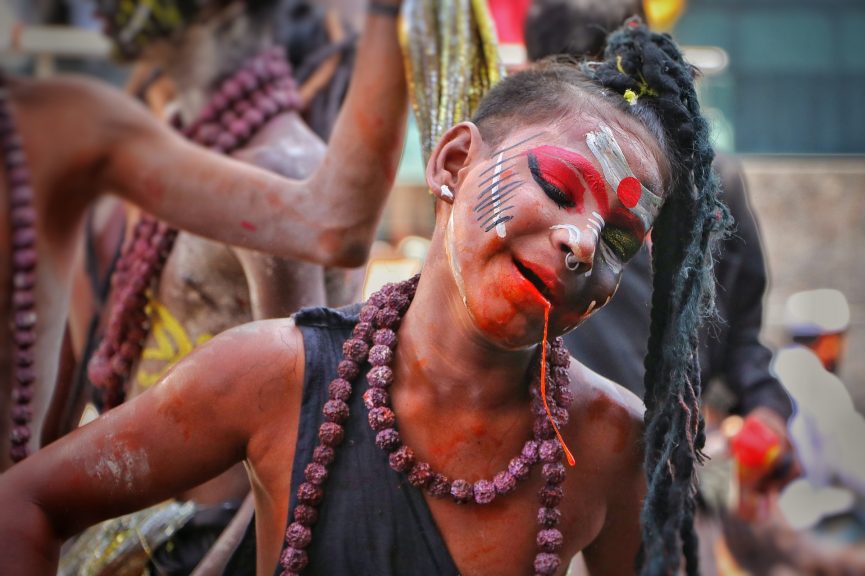
India Climate Guide – Best Time to Visit Attractive Destinations
| Destination | Jan | Feb | Mar | Apr | May | Jun | Jul | Aug | Sep | Oct | Nov | Dec |
| Agra | 22°C, 14mm ✔️ Cool and dry. Great for sightseeing. | 26°C, 10mm ✔️ Cool and dry. Excellent for visiting the Taj Mahal. | 32°C, 10mm ✔️ Warm and dry. Ideal for exploring the city. | 38°C, 4mm ✖ Very hot. Outdoor activities may be uncomfortable. | 42°C, 13mm ✖ Extreme heat. Avoid outdoor activities in the afternoon. | 41°C, 51mm ✖ Very hot and humid. Prefer indoor activities. | 35°C, 207mm ✖ Monsoon. Heavy rain, not ideal for travel. | 33°C, 272mm ✖ Monsoon. Expect continuous rain. | 33°C, 127mm ✖ Warm and humid. Better for indoor activities. | 33°C, 30mm ✔️ Warm and dry. Pleasant for sightseeing. | 29°C, 4mm ✔️ Cool and dry. Ideal weather for visiting. | 24°C, 5mm ✔️ Cool and dry. Great for exploring the area. |
| Amritsar | 19°C, 27mm ✔️ Cool and dry. Great for cultural visits. | 23°C, 28mm ✔️ Pleasant . Good for outdoor activities. | 27°C, 38mm ✔️ Warm and dry. Ideal for sightseeing. | 34°C, 19mm ✔️ Warm and dry. Great for exploring the city. | 39°C, 17mm ✖ Hot and dry. Outdoor activities may be uncomfortable. | 40°C, 53mm ✖ Very hot and humid. Best to stay indoors. | 36°C, 207mm ✖ Monsoon.Heavy rain, not ideal for travel. | 34°C, 182mm ✖ Monsoon. Frequent rain. | 35°C, 94mm ✖ Warm and humid. Indoor activities preferred. | 32°C, 14mm ✔️ Warm and dry. Pleasant for outdoor activities. | 27°C, 6mm ✔️ Cool and dry. Great for cultural exploration. | 21°C, 15mm ✔️ Cool and dry. Ideal for visiting the city. |
| Calcutta | 27°C, 14mm ✔️ Warm and dry. Great for exploring the city. | 29°C, 22mm ✔️ Pleasantly warm and dry. Ideal for sightseeing. | 34°C, 29mm ✔️ Warm and dry. Pleasant for travel. | 36°C, 51mm ✖ Hot and humid. Outdoor activities may be uncomfortable. | 35°C, 125mm ✖ Very hot and humid. Indoor activities recommended. | 33°C, 299mm ✖ Monsoon. Heavy rain, not ideal for travel. | 32°C, 375mm ✖ Monsoon. Continuous rain, expect disruptions. | 32°C, 338mm ✖ Monsoon. Frequent showers. | 32°C, 303mm ✖ Warm and humid. Better for indoor activities. | 32°C, 141mm ✔️ Warm and dry. Good for sightseeing. | 29°C, 26mm ✔️ Warm and dry. Ideal weather for visiting. | 26°C, 8mm ✔️ Cool and dry. Great for exploring the city. |
| Chennai | 29°C, 16mm ✔️ Pleasantly warm and dry. Good for sightseeing. | 31°C, 3mm ✔️ Warm and dry. Ideal for travel. | 33°C, 2mm ✔️ Warm and dry. Pleasant for outdoor activities. | 35°C, 11mm ✔️ Warm and dry. Great for exploring. | 38°C, 36mm ✖ Very hot and humid. Prefer indoor activities. | 38°C, 56mm ✖ Hot and humid. Not ideal for outdoor activities. | 36°C, 108mm ✖ Monsoon. Expect heavy rain. | 35°C, 149mm ✖ Monsoon. Continuous rain, better for indoor activities. | 34°C, 118mm ✖ Warm and humid. Monsoon, expect disruptions. | 32°C, 239mm ✖ Heavy rain. Indoor activities preferred. | 29°C, 325mm Monsoon. Frequent rain. | 29°C, 122mm ✔️ Warm and dry. Pleasant for travel. |
| Cochin | 32°C, 20mm ✔️ Warm and dry. Ideal for backwater tours. | 32°C, 34mm ✔️ Warm and dry. Great for sightseeing. | 33°C, 50mm ✔️ Warm and dry. Good for outdoor activities. | 33°C, 141mm ✖ Hot and humid. Expect some showers. | 32°C, 387mm ✖ Very humid. Rainy season begins, heavy rain. | 29°C, 727mm ✖ Monsoon . Frequent rain, not ideal for travel. | 29°C, 706mm ✖ Monsoon. Continuous rain, prefer indoor activities. | 29°C, 375mm ✖ Monsoon. Heavy rain. | 29°C, 305mm ✖ Warm and humid. Better for indoor activities. | 30°C, 306mm ✖ Monsoon. Frequent rain. | 31°C, 165mm ✔️ Warm and dry. Pleasant for travel. | 32°C, 49mm ✔️ Warm and dry. Great for exploring the area. |
| Darjeeling | 11°C, 17mm ✔️ Cool and dry. Great for trekking. | 13°C, 16mm ✔️ Cool and dry. Ideal for sightseeing. | 17°C, 44mm ✔️ Warm and dry. Good for outdoor activities. | 20°C, 86mm ✔️ Warm and dry. Pleasant for travel. | 21°C, 170mm ✖ Very humid. Rainy season begins, expect rain. | 21°C, 492mm✖ Monsoon. Heavy rain, not ideal for travel. | 21°C, 731mm ✖ Monsoon. Continuous rain, prefer indoor activities. | 21°C, 568mm ✖ Monsoon. Heavy rain. | 21°C, 397mm ✖ Warm and humid. Better for indoor activities. | 20°C, 112mm ✔️ Warm and dry. Pleasant for travel. | 17°C, 15mm ✔️ Cool and dry. Great for sightseeing. | 14°C, 4mm ✔️ Cool and dry. Ideal for trekking. |
| Delhi | 21°C, 15mm ✔️ Cool and dry. Great for cultural visits. | 24°C, 9mm ✔️ Pleasant weather. Good for outdoor activities. | 30°C, 12mm ✔️ Warm and dry. Ideal for sightseeing. | 36°C, 4mm ✖ Very hot. Outdoor activities may be uncomfortable. | 40°C, 11mm ✖ Extreme heat. Avoid midday sun. | 40°C, 38mm ✖ Very hot and humid. Prefer indoor activities. | 35°C, 200mm ✖ Monsoon. Heavy rain, not ideal for travel. | 34°C, 233mm ✖ Monsoon. Frequent showers. | 34°C, 108mm ✖ Warm and humid. Better for indoor activities. | 33°C, 25mm ✔️ Warm and dry. Pleasant for sightseeing. | 29°C, 3mm ✔️ Cool and dry. Ideal weather for visiting. | 23°C, 5mm ✔️ Cool and dry. Great for exploring the city. |
| Goa | 32°C, 0mm ✔️ Warm and dry. Perfect for beach activities. | 32°C, 0mm ✔️ Warm and dry. Great for sightseeing. | 33°C, 0mm ✔️ Warm and dry. Ideal for beach vacations. | 34°C, 12mm ✔️ Warm and dry. Pleasant for outdoor activities. | 34°C, 79mm ✖ Hot and humid. Pre-monsoon showers, expect some rain. | 31°C, 792mm ✖ Monsoon season. Heavy rain, not ideal for beach activities. | 30°C, 959mm ✖ Monsoon. Continuous rain, prefer indoor activities. | 29°C, 536mm ✖ Monsoon season. Heavy showers. | 30°C, 261mm ✖ Warm and humid. Better for indoor activities. | 32°C, 133mm ✔️ Warm and dry. Pleasant climate for travel. | 32°C, 32mm ✔️ Warm and dry. Great for beach activities. | 32°C, 11mm ✔️ Warm and dry. Ideal for sightseeing. |
| Jaipur | 23°C, 9mm ✔️ Cool and dry. Great for cultural visits. | 25°C, 8mm ✔️ Pleasant. Good for outdoor activities. | 31°C, 7mm ✔️ Warm and dry. Ideal for sightseeing. | 37°C, 3mm ✖ Very hot. Outdoor activities may be uncomfortable. | 40°C, 14mm ✖ Extreme heat. Avoid midday sun. | 39°C, 50mm ✖ Very hot and humid. Prefer indoor activities. | 34°C, 196mm ✖ Monsoon season. Heavy rain, not ideal for travel. | 32°C, 211mm ✖ Monsoon. Frequent rain. | 34°C, 84mm ✖ Warm and humid. Better for indoor activities. | 34°C, 11mm ✔️ Warm and dry. Pleasant for sightseeing. | 29°C, 3mm ✔️ Cool and dry. Ideal weather for visiting. | 24°C, 5mm ✔️ Cool and dry. Great for exploring the city. |
| Jodhpur | 25°C, 3mm ✔️ Cool and dry. Great for cultural visits. | 28°C, 3mm ✔️ Pleasant climate. Good for outdoor activities. | 33°C, 3mm ✔️ Warm and dry. Ideal for sightseeing. | 38°C, 2mm ✖ Very hot. Outdoor activities may be uncomfortable. | 42°C, 7mm ✖ Extreme heat. Avoid midday sun. | 40°C, 31mm ✖ Very hot and humid. Prefer indoor activities. | 36°C, 123mm ✖ Monsoon. Heavy rain, not ideal for travel. | 33°C, 126mm ✖ Monsoon season. Frequent showers. | 35°C, 57mm ✖ Warm and humid. Better for indoor activities. | 36°C, 4mm ✔️ Warm and dry. Pleasant for sightseeing. | 31°C, 3mm ✔️ Cool and dry. Ideal weather for visiting. | 27°C, 2mm ✔️ Cool and dry. Great for exploring the city. |
| Ladakh | -3°C, 12mm ✖ Very cold. Snowy, not ideal for travel. | -2°C, 12mm ✖ Very cold. Snowy, not ideal for travel. | 4°C, 15mm ✔️ Cold and dry. Great for trekking. | 10°C, 12mm ✔️ Cold and dry. Ideal for adventure sports. | 13°C, 13mm ✔️ Cool and dry. Pleasant weather for outdoor activities. | 17°C, 16mm ✔️ Warm and dry. Good for sightseeing. | 22°C, 30mm ✔️ Warm and dry. Ideal for trekking. | 21°C, 31mm ✔️ Warm and dry. Great for adventure sports. | 18°C, 13mm ✔️ Cool and dry. Pleasant for travel. | 12°C, 3mm ✔️ Cold and dry. Good for sightseeing. | 6°C, 5mm ✔️ Cold and dry. Ideal for trekking. | 0°C, 8mm ✖ Very cold. Snowy, not ideal for travel. |
| Mumbai | 28°C, 0mm ✔️ Warm and dry. Great for beach activities. | 29°C, 1mm ✔️ Warm and dry. Ideal for sightseeing. | 31°C, 0mm ✔️ Warm and dry. Good for outdoor activities. | 32°C, 0mm ✔️ Warm and dry. Pleasant climate for travel. | 33°C, 11mm ✖ Hot and humid. Pre-monsoon showers, expect some rain. | 32°C, 551mm ✖ Monsoon season. Heavy rain, not ideal for beach activities. | 30°C, 885mm ✖ Monsoon. Continuous rain, prefer indoor activities. | 29°C, 620mm ✖ Monsoon season. Heavy rain showers. | 30°C, 366mm ✖ Warm and humid. Better for indoor activities. | 32°C, 66mm ✔️ Warm and dry. Pleasant for sightseeing. | 32°C, 5mm ✔️ Warm and dry. Ideal weather for visiting. | 30°C, 1mm ✔️ Warm and dry. Great for exploring the city. |
| Shimla | 10°C, 69mm ✔️ Cool and dry. Great for mountain views. | 12°C, 65mm ✔️ Cool and dry. Ideal for trekking. | 16°C, 73mm ✔️ Warm and dry. Pleasant weather for sightseeing. | 21°C, 44mm ✔️ Warm and dry. Great for outdoor activities. | 25°C, 59mm ✔️ Warm and dry. Ideal for travel. | 26°C, 150mm ✖ Monsoon season. Expect heavy rain, better for indoor activities. | 22°C, 394mm ✖ Monsoon season. Continuous rain, not ideal for travel. | 21°C, 314mm ✖ Monsoon. Frequent rain showers. | 21°C, 168mm ✔️ Warm and dry. Good for sightseeing. | 19°C, 44mm ✔️ Warm and dry. Pleasant for travel. | 16°C, 13mm ✔️ Cool and dry. Ideal for trekking. | 12°C, 30mm ✔️ Cool and dry. Great for mountain views. |
| Varanasi | 24°C, 22mm ✔️ Cool and dry. Great for cultural visits. | 27°C, 9mm ✔️ Pleasant weather. Good for outdoor activities. | 34°C, 11mm ✔️ Warm and dry. Ideal for sightseeing. | 39°C, 3mm ✖ Very hot. Outdoor activities may be uncomfortable. | 42°C, 9mm ✖ Extreme heat. Avoid midday sun. | 39°C, 86mm ✖ Very hot and humid. Prefer indoor activities. | 33°C, 281mm ✖ Monsoon season. Heavy rain, not ideal for travel. | 32°C, 281mm ✖ Monsoon. Frequent rain showers. | 33°C, 192mm ✖ Warm and humid. Better for indoor activities. | 33°C, 36mm ✔️ Warm and dry. Pleasant for sightseeing. | 29°C, 7mm ✔️ Cool and dry. Ideal weather for visiting. | 25°C, 5mm ✔️ Cool and dry. Great for exploring the city. |
- ✔️ Ideal or pleasant climate: Suitable for most outdoor activities, sightseeing, and travel.
- ✖ Not ideal, extreme temperatures or heavy rainfall: Not recommended for travel due to extreme weather conditions or heavy rains.
When is the Tourist Season in India?
Best Time to Visit India: November to early March
- Weather: Moderate to relatively cool temperatures in Central India, South India, and flat parts of North India
- Special Note: High Himalayas in the far north may be inaccessible in December and January
October: Early Season Option
- Climate: Pleasant and dry weather, slightly hot afternoons
- Festivals: Diwali (late October or early November)
Booking Tip:
- Advance Booking: At least 3 months ahead for the best hotels and hassle-free train reservations
Crowded Destinations:
- Popular Spots: Rajasthan, Agra, Goa, Kerala
- Peak Crowd: Christmas and New Year, especially in Goa
Why Visit India During Peak Season?
- Atmosphere: Lively with plenty of fellow travelers
- Experience: Enjoy the buzz and excitement of India in full swing
The tourist season in India is generally from November to the beginning of March, which is also the best time to visit the country. You will find a lot of international visitors in India during this time. The country starts heating up from March onwards.
This is when India has moderate to relatively cool temperatures in Central and South India and some flat parts of North India. Certain parts of the high Himalayas in the far north are inaccessible in December and January, but by and large, you can expect clear skies and dry and sunny days across India, along with great beach weather.
October is a good month to visit most of the country. The climate is dry and pleasant, and still early for the tourist influx. The afternoons in October can be a little hot, our only grudge with the month in India. Diwali, India’s biggest Hindu festival, is celebrated either in late October or early November.
Click on Plan Your Trip, if you want us to help you with it!
If you plan your holiday during this time, it is best to book at least three months in advance to get the best pick of hotels at reasonable rates and hassle-free train reservations.
Prime tourist destinations such as Rajasthan, Agra, Goa and Kerala get quite crowded at this time. On Christmas day and New Year, Goa in particular is completely packed with domestic tourists and international visitors.
Apart from the cooler temperatures, if you like meeting other interesting travellers, as well as the buzz, and excitement while you travel, then there’s nothing quite like seeing India in peak tourist season.
Check out our tour ideas, almost all of which could be executed in these months.
Seasons in India
Winter (October to March)
- Best Time to Visit: Ideal for exploring most parts of India
- Tourism: Thrives across the country
Monsoon (Mid-June to September)
- Weather: Heavy rains, especially in South India (Kerala, Goa, Mumbai)
- Travel Tip: Generally not recommended due to intense rains. Most national parks close for the season.
- Pros: lush green scenery, fewer crowds, cheaper rates
- Secret: North India gets light showers, making it a great weather for exploring in August and September
- Festivals: Monsoon is celebrated with various festivals, particularly by farmers
Summer (March to Mid-June)
- Weather: Can reach up to 45°C in some regions
- Best Regions to Visit: North India
- Destinations:
- Rishikesh: Spiritual haven on the Ganges River
- Dharamshala: Home of the exiled Dalai Lama
- Hill Stations: Shimla, Darjeeling, etc.
- Trekking: Thrill-seekers can explore trekking routes in North India such as Himachal Pradesh and Uttarakhand
- Ladakh: Becomes accessible by June
- Destinations:
While the winter months are perfect for a trip to India, tourism in India thrives throughout the year.
Monsoon rains start from mid to late June and last until September. This wet season is an exotic concept for travellers coming from moderate climate zones. The monsoon rains make it an off-season for tourism.
The rainy season develops differently in different parts of India, but it can rain very intensely in the southern part of India (think Kerala, Goa, and Mumbai). You can expect torrential rains in a large part of the country in July. Often, the rains can severely disrupt communications, especially in the remote areas. The low-lying delta lands and jungle regions of West Bengal often get flooded during the heavy rain.
Monsoons are not recommended for travel in India, but this is when nature comes to life in India. It is a magical time. Grasslands and forests become lush green. Monsoon is celebrated with extremely varied festivals across India, especially by farmers.
Another benefit of the season is that since many people avoid travelling in monsoons, you get cheaper rates for everything, less crowds, and incredible views. A little secret: most parts of North India only receive light showers during the monsoons – a great region to explore, especially during the months of August and September.
March to June is the summer season in India. During these months, plus some weeks of October, temperatures can go up to 45 degrees Celsius in some parts of India. But that shouldn’t stop you from visiting India. Summer months are perfect to take a trip to North India, amidst the great Himalayan ranges.
You can venture to the spiritual haven of Rishikesh, which lies on the banks of the Ganges River. You can even visit the exiled Dalai Lama in Dharamshala.
British hill stations like Shimla or Darjeeling are great to visit, while thrill-seekers can trek in various regions of North India. Ladakh becomes accessible by June.
Take a look at Stephanie’s spiritual voyage through the North for some inspiration on a travel route through this region.
Festivals in India
Diwali (Festival of Lights)
- When: Late October or early November
- Highlights: Homes and streets illuminated with oil lamps, exchange of sweets and gifts, firecrackers, and welcoming Goddess Lakshmi.
- Why Go: A dazzling and vibrant celebration that must be witnessed.
Holi (Festival of Colors)
- When: March
- Highlights: Playful drenching in colored powders and water, celebrates the triumph of good over evil.
- Where: Celebrated widely in northern India and parts of southern India.
- Why Go: Perfect to experience if visiting the Golden Triangle region (Delhi, Agra, Jaipur).
August to October Festivals
- Ganesh Chaturthi: Hindu Festival dedicated to the elephant-headed God, Ganesha
- Onam: Ten-day harvest festival in Kerala.
- Navratri: Nine-day festival celebrating the nine incarnations of Goddess Durga.
- Dussehra: Religious festival based on Hindu mythology.
Pushkar Camel Fair
- When: November
- Where: Rajasthan
- Highlights: Traditional camel trading market, Rajasthani food, music, dance, cultural immersion, and camel-centric activities.
- Why Go: An unforgettable adventure blending culture and festivity.
Lohri
- When: January
- Where: Northern India
- Highlights: Folk dances (Bhangra, Gidda), traditional sweets (rewari, gajak).
- Why Go: Celebrates the beginning of the harvesting season.
Travel Tips During Festivals
- Homestay Experience: Consider staying at a homestay in North or South India to immerse yourself in local and intimate family celebrations.
- Advance Booking: Trains and flights get booked early around festivals as many Indians travel to be with family. Book well in advance to avoid higher costs and secure your plans.
When is the best time for visiting India for its festivals? Well, India has many, many national and local festivals throughout the year.
However, there are a few large festivals in India that you absolutely should not miss. So try to time your travel in India around at least one of the major festivals to truly take in the vibrance of India.
Diwali, the festival of lights, is usually in late October or the beginning of November. This is one of the most amazing times to visit India. Homes and streets are illuminated with ‘diyas’ or oil lamps. People exchange sweets and gifts and burst firecrackers. Goddess Lakshmi is welcomed on this auspicious festival. This dazzling festival is truly something to be witnessed.
Holi, the festival of colors, is in March. Join locals in a riot of vibrant hues as they playfully drench each other in coloured powders and water. Celebrated in most of northern India and some parts of India’s south, the Holi festival celebrates the triumph of good over evil. If you are planning to visit northern India with the Golden Triangle in mind (Delhi, Agra and Jaipur), then you must witness the Holi festival along your Golden Triangle route.
August, September, and October see a range of festivals dedicated to Gods and Mother Earth across the country. These include Ganesh Chaturthi (festival dedicated to the elephant-headed God), Onam (ten-day harvest festival in Kerala), Navratri (nine-day festival to celebrate the nine incarnations of Goddess Durga), and Dussehra (a religious festival based on Hindu mythology).
Held in November, Rajasthan’s Pushkar Camel Fair blends a traditional camel trading market with colourful festivities. Engage in traditional Rajasthani food, music and dance. The fair’s lively energy, cultural immersion, delicious shopping and camel-centric activities make the Camel Fair an unforgettable adventure.
Embrace the warmth of Lohri in northern India in January. This festival marks the beginning of the harvesting season. Witness folk dances like Bhangra and Gidda, enjoy delicious traditional sweets like ‘rewari’ and ‘gajak’.
While it’s great to see and take part in local festivities and ceremonies, a lot of festivals in India are intimate family celebrations. Therefore, it would be best to stay at a homestay either North or South India at that time. Just before and after festivals, trains get booked way in advance and flights are extremely costly. This is because most Indians travel to be with their families. So, try and do the same and book well in advance.
The festive seasons may not always coincide with the holiday dates you had in mind. If you just give us a shout, we’ll help you plan the ideal trip while making sure you experience a traditional festive celebration or cultural event. There’s always something great going on in India, and we know exactly when and where.
When is the Best Time to Visit Delhi?
The best time to visit Delhi would be from October to early March, as the weather is cool and pleasant at this time. It gets quite cold from December to February, so do carry warm clothes. With the increasing pollution in India, we also recommend carrying a mask.
The summer months of April to June are incredibly hot, so restrict sightseeing to mornings and evenings, and spend the afternoons indoors eating some delicious Delhi food.

When is the Best Time to Visit Agra?
The best time to visit Agra and the Taj Mahal is between November and March. The weather is similar to that of Delhi – winters get cold and summers are intensely hot and humid.
You can do the Golden Triangle route by combining Delhi and Agra along with Jaipur. This way, you get to visit many popular tourist attractions and get exposed to many different cultures in one trip.
If you don’t mind the rain and high humidity, monsoons are a good time to visit Agra for low prices and fewer tourists.
Taj Mahal is an attractive destination in India and is quite crowded most of the time. The best time to visit the Taj Mahal is early morning, to avoid crowds and see the warm sun hit the marble in a surreal way. Do note that the Taj Mahal is closed on Fridays.
When is the Best Time to Visit Rajasthan?
The best time to visit Rajasthan is from November to March. The weather is ideal to visit the forts of Jaipur and Jodhpur, see the Thar desert, or relax by the lakes in Udaipur.
It is also the best time to spot the majestic tiger at Ranthambore. March is also when you can celebrate Holi festival in Rajasthan.
The summer months from April to June are avoidable due to excess heat and hot winds.
The monsoons are a good time to visit Rajasthan because the rains are not heavy, you get relatively cooler temperatures, and prices are much cheaper.
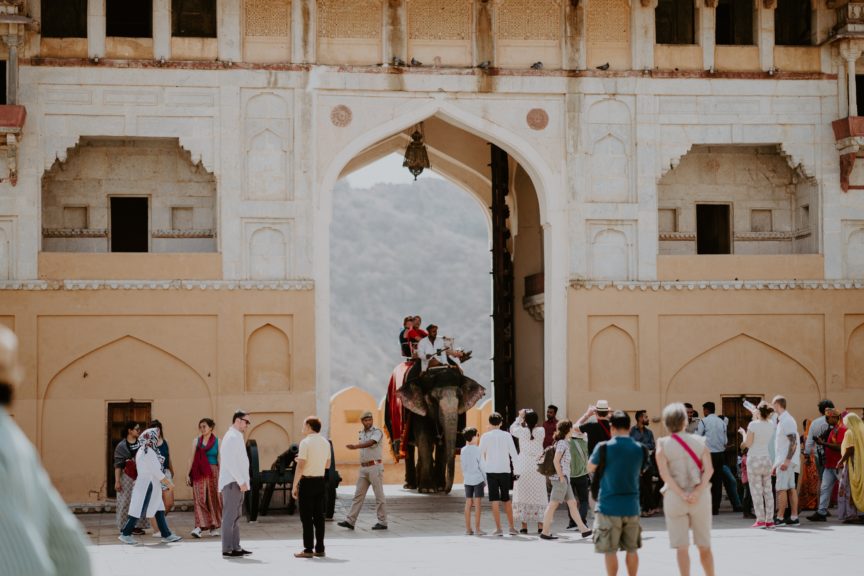
When is the best Time to visit Goa?
The best time to visit Goa is December to February. This is the high season in the state – the weather is pleasant and not very humid. With its party places to let loose and beach resorts to relax, Goa is a fun place to visit in India.
The only time to avoid Goa is during the monsoons, between June and September. However, the monsoons in Goa show you a different, incredible side of this beach state. While you won’t be able to do any water activities during this season, you can definitely enjoy a staycation at one of the beach resorts in Goa. Plus, you will get low prices on accommodations due to the off season.
When is the Best Time to Visit Central India?
The best time to visit Central India is from November to February. This is the dry season in this region. The weather is similar to that of North India. Being away from the sea, this region gets a lot less rain than the coastal states, resulting in very cold winters and extremely hot temperatures with dry weather during summers.
Central India is quite vast and spread out. From the states of Uttar Pradesh, Madhya Pradesh, to parts of Maharashtra, central India has some of the more offbeat and untouched places to visit.
There are many national parks for tigers in Central India (Tadoba, Pench, Kanha, and Bandhavgarh). The best time to spot tigers would be in the summer (March to June).
Uttar Pradesh has the holy city of Varanasi. Madhya Pradesh has some lovely cities like Indore and Bhopal and some historical places like Ujjain and Mandu. Further up north are Khajuraho and Orchaa, where you can explore ancient temples dating back to 950 A.D.
When is the Best Time to Visit the Western Coastline of India?
Along the western coastline runs the massive 1600 km long Western Ghats mountain range. It contains beautiful hill stations, a variety of flora and fauna, and wildlife parks, forest and natural reserves that make it a UNESCO World Heritage Site.
Wayanad, Coorg, Munnar and Coonoor are some of the places you can visit to escape the heat.
Every time you leave the plains and enter the mountainous regions between the summer months, you immediately feel the change in temperature and air quality. Since off-season for tourism in India starts in April, you’ll already save substantially on hotel bookings.
When is the Best Time to Visit South India?
The best time to visit South India is from November to March. You can expect clear blue skies, green scenery, calm seas, and cool mountain air.
You can visit the Araku Valley or beaches of Vishakhapattnam in Andhra Pradesh on the east coast of India. Andhra Pradesh has a rich cultural heritage and some stunning views. The tea plantations in Munnar and the forests of Wayanad, Thekkady and Thattekad in Kerala will have nice, pleasant climate and sunny days. Pongal, a four-day harvest festival, is celebrated in Tamil Nadu in January or February.
Tamil Nadu also experiences the retreating monsoons between October and December from the northeast winds. You can see the waterfalls in all their glory during the monsoon, but you can also expect a lot of rain, so be prepared accordingly.
Summers are hot and humid in southern India, but not unbearable like in the Northern part of the country.
The temperature is cool in hill stations of Nilgiri Hills in Tamil Nadu even during summer. This is also the best time to spot elephants in the Periyar National Park in Kerala and the Bandipur National Park in Karnataka.
Know More: Best Time to Visit Kerala
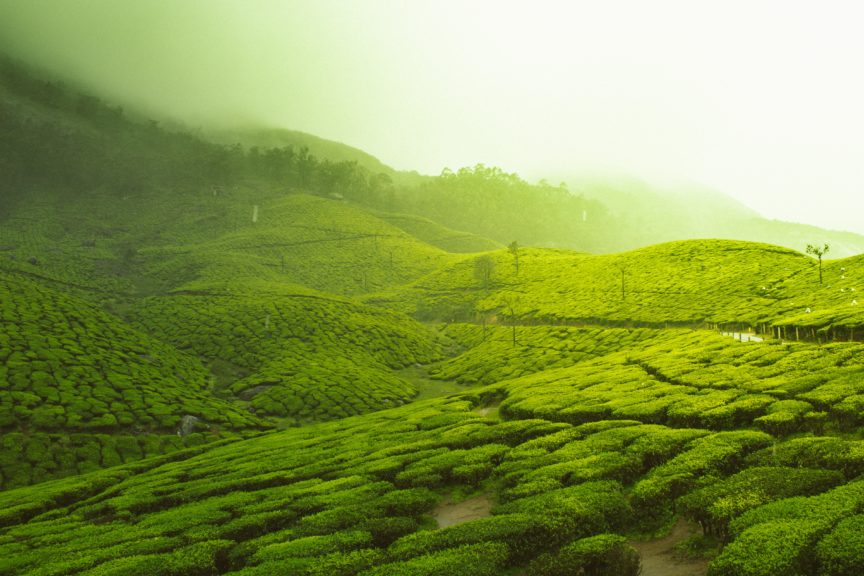
Also, check out our Blog Weather Series for the different months in India. If you’re still not sure when and where to travel when visiting India, plan your trip with us and we can help you with all the travel advice. At India Someday, we plan tailor made tours for you according to your requirements.
BEST TIME To VISIT INDIA VIDEO
Frequently Asked Questions
India has an extremely varied geography and climate, which is why tourism flourishes in the country throughout the year. No matter when you visit India, there is always something to look forward to. However, one of the best times for visiting India is in February, when most of the country has a pleasant climate. November to March is the high season for tourism in India.
The best season to visit India is the winter season. Most of India has a pleasant, cool climate, with the only exceptions being the far north and Delhi regions, which can get extremely cold. This is also the peak travel season in India.
The best time of the year to visit the Taj Mahal would be between October and March. Do remember that the Taj Mahal is closed every Friday. You can also do the Golden Triangle route (Delhi – Agra – Jaipur), where, along with the Taj Mahal, you can also visit the Red Fort, Hawa Mahal, India Gate, Lotus Temple, and City Palace on the trip.
The best months for visiting India are November and February. These are not peak tourist seasons like December and January and have glorious weather in most of India, cool and pleasant.
The best months to visit Delhi are between October and March. However, we recommend dates toward February and March.
Monsoon starts in different parts of India at different times. In the west coast and northern India, the rainy season starts from mid-June and ends in September. In the east coast of Tamil Nadu and Orissa, it rains between October and November. July and August see regular and prolonged downpours in most parts of central and south India. July is the wettest month in India.
The most optimum weather for cities in India would be Bangalore. It has a moderate climate all through the year.
May is the hottest month in India, with average temperatures ranging from 30 to 42 degrees Celsius. In many places such as Rajasthan, Uttar Pradesh, and Delhi, temperatures can exceed 45 degrees Celsius.
The monsoon season from June to September is the cheapest time to visit India.
helping you travel your way
Everything you need to know about India is here We have tried writing about everything you may need help with for your trip to India, If you need help in planning a trip to India Get in touch with us to to plan your trip of a life time.



